
Wednesday March 27, 2019
By Mina al-Lami
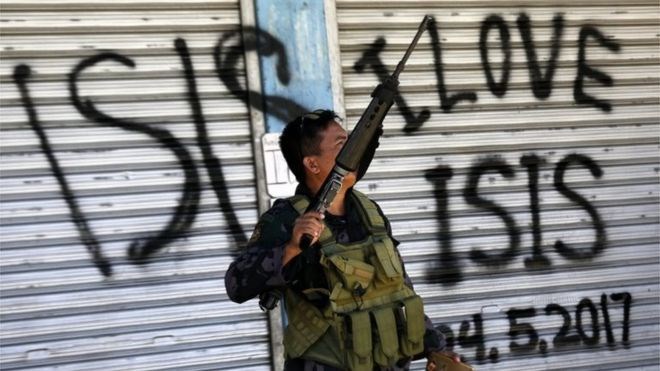
The Philippines has seen an uptick in IS attacks in recent years
After months of fighting, the
jihadist group Islamic State (IS) has finally lost Baghuz, a village in
eastern Syria that came to represent the final chapter in its
self-styled caliphate.
While this is a major blow, the loss of the
small enclave near the Iraqi border does not spell the end of IS as a
militant group capable of mounting deadly attacks worldwide.IS
and its affiliates continue to be active in various countries, claiming
attacks on a daily basis through the group's online propaganda outlets.
Data
collected by BBC Monitoring shows that despite having lost most of its
territory in Syria and Iraq at the end of 2017, IS said it was behind
3,670 attacks worldwide last year - an average of 11 attacks per day -
and 502 attacks in the first two months of 2019, while Baghuz was under
siege.
There was a peak in IS attack claims in September 2018. This was
likely to have been linked to the start that month of an operation by
the US-backed Syrian Democratic Forces (SDF) alliance to take the IS
stronghold of Hajin, north of Baghuz.
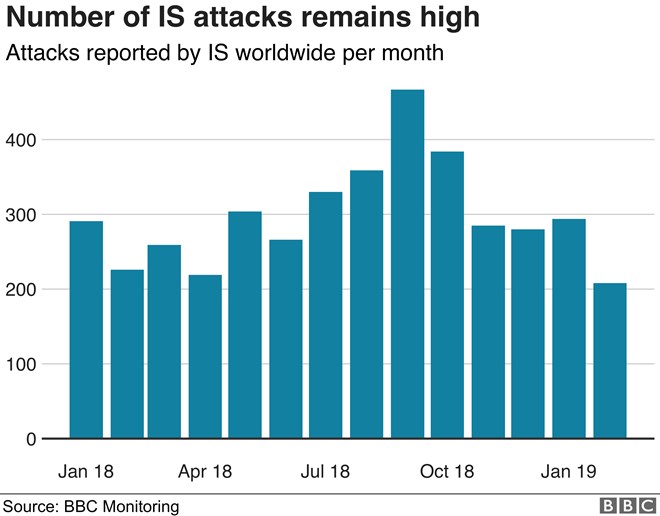
The jihadist group commonly
steps up its attacks in response to offensives against it, either in
the area under siege or elsewhere to divert attention or resources away
from there.
Although Iraq and Syria continue to account for the
lion's share of IS attack claims, Afghanistan, Somalia, the Philippines,
Nigeria and Egypt's Sinai peninsula also feature regularly.
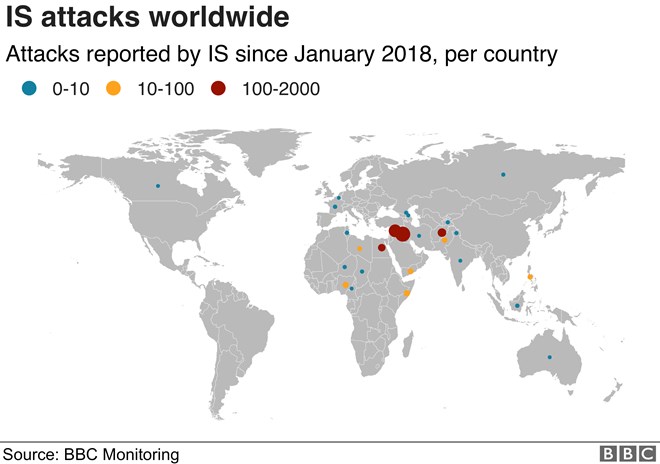
In a recent message, the IS leadership mocked US President Donald
Trump's claim in December to have defeated the group, and insisted that
it was far from over.
Nevertheless, IS's caliphate model has been
over since late 2017, when it lost its strongholds of Mosul in Iraq and
Raqqa in Syria. After that, the group struggled to project the image of
a functioning and flourishing state - which had formed the basis of its
claim to have revived the caliphates of early Islam.
How data on IS activity was gathered
The
data is based exclusively on what the group itself has claimed through
its official "Nashir News Agency" media outlets on the messaging app
Telegram. The dates reflect when IS said the attacks took place, rather
than when the claim was published.
The data includes every claim
of attack, no matter how small or inconsequential. Most attacks that IS
claimed solely through its weekly newspaper al-Naba without issuing a
separate statement were not reflected in the data.
It is worth noting that IS, like any jihadist group, has a tendency to exaggerate the scale of its attacks and their impact.
IS has officially declared that it has a presence in
the following countries and regions: Iraq, Syria, Libya, Egypt, Yemen,
Saudi Arabia, Algeria, "Khorasan" (the Afghanistan-Pakistan region),
"the Caucasus", "East Asia" (mostly active in the Philippines), Somalia,
and "West Africa" (mostly active in Nigeria).
Some of these
branches, such as Algeria and Saudi Arabia, have barely claimed any
activity, and others like "the Caucasus" rarely claim attacks.
The
group recently signalled through its propaganda an intention to step up
its activity in Tunisia, a country where it has so far failed to make
inroads following the 2015 attacks on a museum and beach resort that it
claimed. IS also announced for the first time a presence in Burkina
Faso.
The announcements about Tunisia and Burkina Faso suggest
that at least in terms of propaganda, IS is keen to indicate that its
trademark slogan "Remaining and Expanding" still applies.
Unsurprisingly, IS's biggest battleground continues to be in Iraq and Syria, where it clearly has its best resources.
Out of a total of 3,670 attacks IS claimed worldwide in 2018, 1,767 were in Iraq (48%) and 1,124 were in Syria (31%).
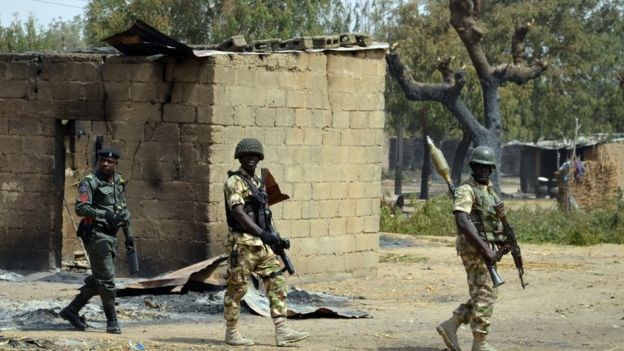 Nigeria's army has increasingly come under attack by a branch of IS in recent months
Nigeria's army has increasingly come under attack by a branch of IS in recent months
But last year also saw a notable increase in claimed activity by
other IS branches. It was as if the group wanted to compensate for its
losses in Iraq and Syria and to remind people that it also operated
outside the Middle East.
In 2018, IS claimed 316 attacks in
Afghanistan, 181 in Egypt's Sinai peninsula, 73 in Somalia, 44 in
Nigeria, 41 in Yemen and 27 in the Philippines.
The number of
attack claims by IS West Africa Province in Nigeria has notably risen in
recent months. The army has been the primary target, possibly because
the group is attempting to seize weaponry and in turn boost its
capability.
IS has claimed 44 attacks in Nigeria in the first three months
of 2019, matching the total number of attacks it claimed in a whole year
in 2018.
In a propaganda video released in January, IS West
Africa Province called on Muslims to migrate to the region and join its
branch, signalling that it was ready to receive foreign recruits.
On
22 March, IS West Africa Province announced for the first time that it
had a presence in Burkina Faso - a country where its rival al-Qaeda has
already carried out several attacks.
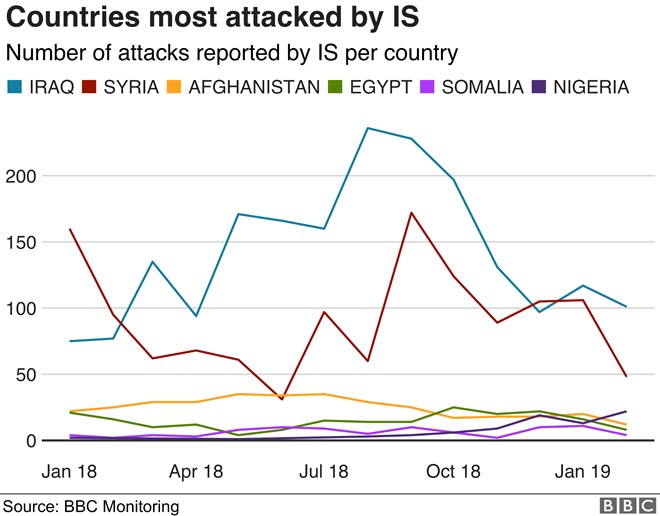
There has also been an uptick in the number of attack claims in the Philippines.
IS
operates in the country through local affiliates, most of which have
been fighting to establish an independent Islamic state in the south for
decades. But their attacks, mostly against the army, are still
sporadic.
And despite repeated calls to its supporters, IS did not claim any major attacks in the West during 2018.
The
previous year, it claimed four attacks in the UK, including the
Manchester Arena bombing; the Barcelona attacks in Spain; and the Las
Vegas shootings in the US. However, some of those claims appeared to
have been opportunistic, as the group failed to provide evidence.
In
2018, IS claimed seven, mostly low-profile attacks in the West that
appeared to have been inspired by the group. They comprised four knife
or gun attacks in France, and one attack each in Belgium, Canada and
Australia.
Data journalism by Will Dahlgreen, Nassos Stylianou and BBC Monitoring